
As I thumb the ignition, my ears are greeted by acoustics both familiar and foreign. The 60-degree V-Twin sounds a little like the old V-Rod’s motor, a liquid-cooled double-overhead-cam powerplant, but this Harley-Davidson is all new from the tires up.
The Pan America is a bold move for a company steeped in tradition like H-D. It’s not just a new motorcycle, it’s a completely new platform with an entirely new engine. The Revolution Max V-Twin shares its bore and stroke with the V-Rod’s Revolution motor, but not even a single bolt carries over to what will be a hugely significant engine for Harley into the future. With its thoroughly modern architecture, the Max cranks out a very impressive 150 horsepower.
Adventure bikes are the hottest class in street motorcycles, even if they’re rarely on these pages. They are renowned for their roomy ergonomics and for being terrific sport-touring machines, not to mention for their ability to traverse interesting unpaved roads that your Street Glide would shake its head at.
If you’re a Buell fan, then you probably remember the adventure-touring Ulysses built around a hot-rodded Sportster engine. Harley was ahead of the curve with the Uly, and now it’s a little tardy with the Pan Am, built to compete with premium bikes in the lucrative ADV market segment.
Amazingly, Harley has entered this competitive class with a bike that can run with the established class leader, BMW’s R1250GS. In some ways, this new Harley even out-pegs the esteemed Beemer.
As illustrated above, the Pan America brings more power, a larger fuel tank, and less weight to the table at a price cheaper than the German ADV stalwart. H-D engineers obviously burned the midnight oil developing the Pan America into something highly competitive in an established field.
Also, take a look at the valve-adjustment intervals. As is typical for H-D, hydraulic valves are used in the Pan Am, which means they never need adjusting. And let’s not forget that H-D has more than 700 dealers scattered all around the USA, while BMW has only about 150.
Oh, and ignore the internet misinformation about the Pan America being built overseas. Its engine is actually made in the Pilgrim Road Powertrain Operations facility in Milwaukee, and the bike is assembled in York, PA.
Party Trick
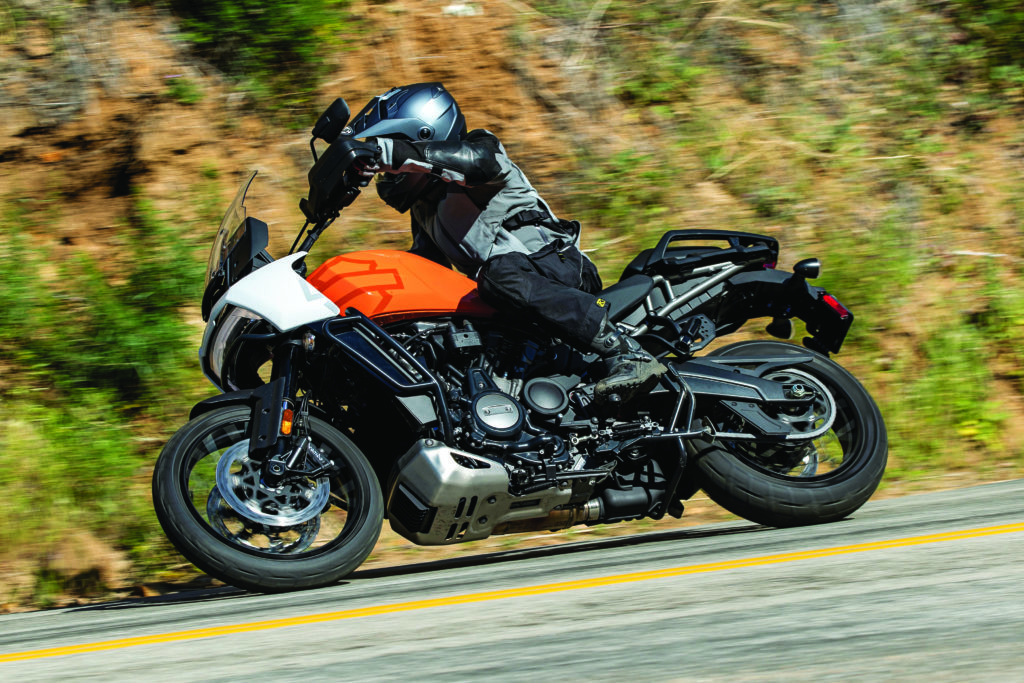
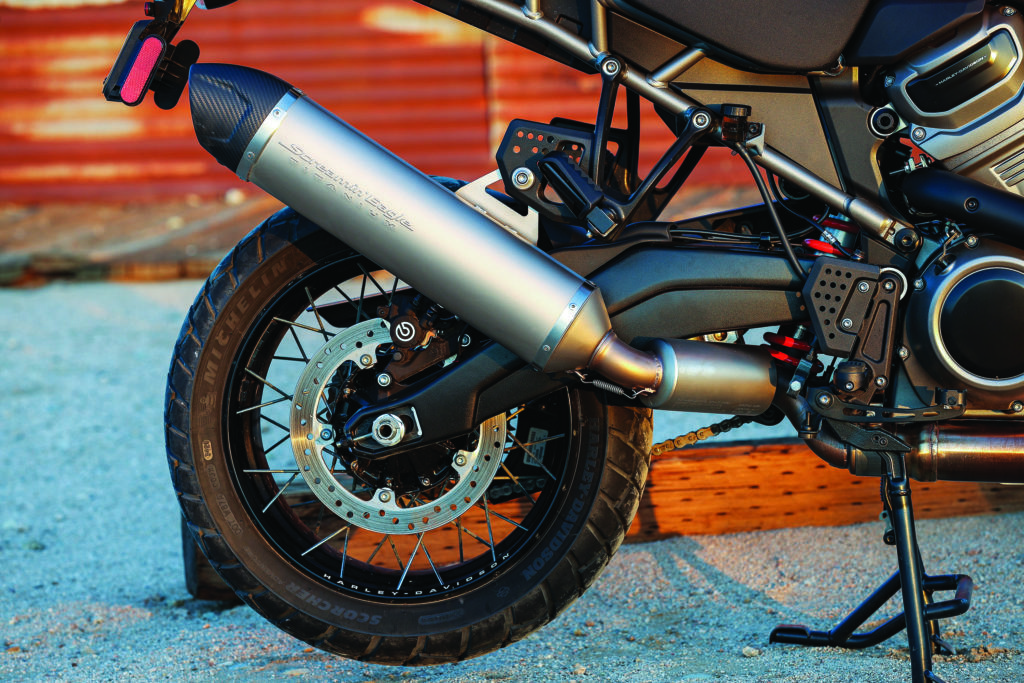
Adventure bikes are revered by tall riders who often feel scrunched up on typical motorcycles. For shorter riders, however, the lofty seat heights of ADVs can be overwhelmingly intimidating. The Pan America 1250’s saddle resides at 34.2 inches when placed in its lower of two positions. The up-spec 1250 Special, with automatic rear preload adjustment, knocks the height down to 33.4 inches – better, but not ideal for someone with 30-inch legs.
The inseam-challenged among us will be thrilled by Harley’s Adaptive Ride Height system. ARH transitions the suspension to a lower ride height when at a stop, then automatically raises it an inch or more, depending on the spring preload electronically selected, once the Pan America is in motion, preserving precious ground clearance.
It’s an industry-first innovation available as an option only on the Special model, which brings down the seat height to 32.7 inches. With a 180-pound rider aboard, the seat sinks to 31.1 inches. Opting for the accessory “Reach” seat brings down that metric to just 29.4 inches!
Or, if you’re built like a basketball player, the Tallboy seat in its high position on the standard Pan America brings the seat more than three feet from the ground. As the saying goes, there’s an ass for every seat.
Beauty?
Okay, we’d be hard-pressed to describe the Pan America as beautiful, but a beautiful adventure bike doesn’t really exist. I appreciate how Harley hasn’t mindlessly aped the beak-like fenders commonly applied to ADV bikes, and we’ve warmed to its distinctive appearance. We also appreciate how the rectangular headlamp array (of 30 LED elements) draws styling inspiration from the Fat Bob and Road Glide. The Special’s adaptive headlight uses six LED panels at the base of the windscreen above the headlight.
Ride On
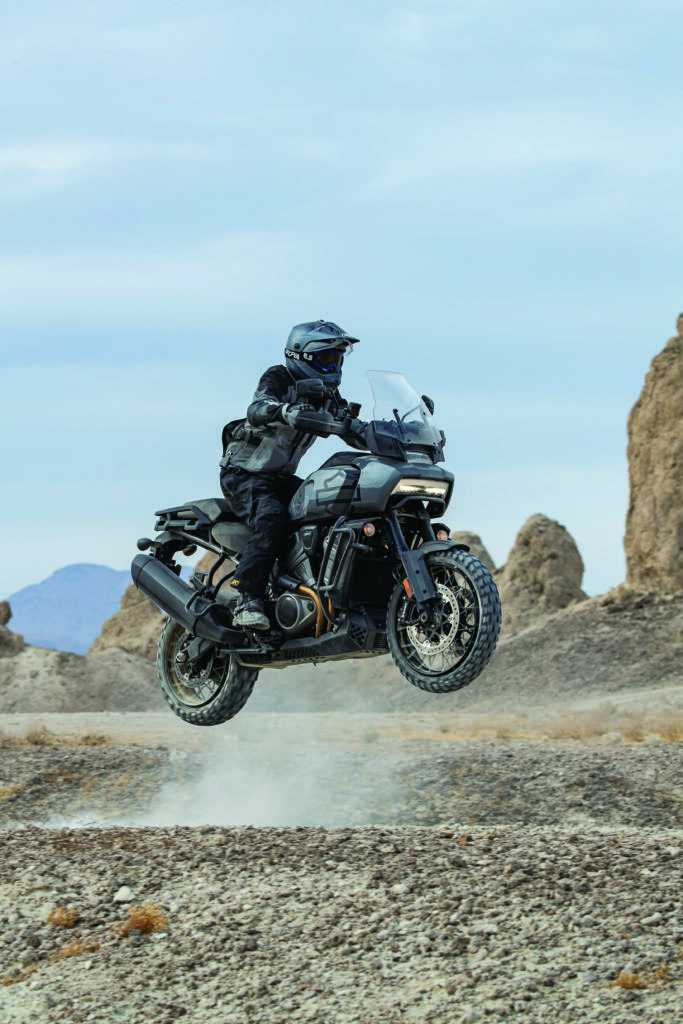
While the badge says Harley-Davidson, this is definitely a different animal than what we’ve come to expect from H-D. The 1,252cc engine throbs like a V-Twin, but it’s a creamier feeling than Harley’s traditional 45-degree motors. Clutch pull is reasonably light, and pulling away from stops is easy-peasy aside from the fact that your butt is at least six inches higher than most Harleys.
The Pan America’s ease of use is aided by its relatively light weight, a reasonable 534 pounds with its lightweight aluminum tank full of 5.6 gallons of fuel. That’s about 20 pounds lighter than Ducati’s similarly spec’d V-Twin Multistrada 1260. The Special’s extra equipment bumps curb weight to 559 pounds. The front frame, the aluminum mid-frame and the tail section bolt directly to the powertrain, a design that reduces overall weight compared to a full cradle frame. A cast-aluminum swingarm minimizes unsprung weight, while lightweight magnesium is used for the engine covers.

Despite its relatively paltry 76 cubic inches, the Max pulls strongly from even low revs thanks to its variable valve timing that optimizes when the valves open and close based on engine speed, throttle openings, and gear position. At the first sight of open road, I pinned the throttle and was nearly swept off the seat by the intense acceleration brought on by 150 galloping ponies roaring to a 9,500-rpm redline. Top performance is obtained with premium fuel, but a knock sensor allows it to run safely on lower-grade gas.
This motor is a stunner, with stout power at all points on the digital tachometer shining vividly from the 6.8-inch thin-film transistor (TFT) instrument panel. When using just whiffs of throttle, the Max purrs away contentedly, with dual counterbalancers quelling vibration at cruising speeds. The seat is comfy and plush but loses support after about an hour. Electronic cruise control eases freeway droning on your way to the fun roads, and fuel range exceeds 200 miles.
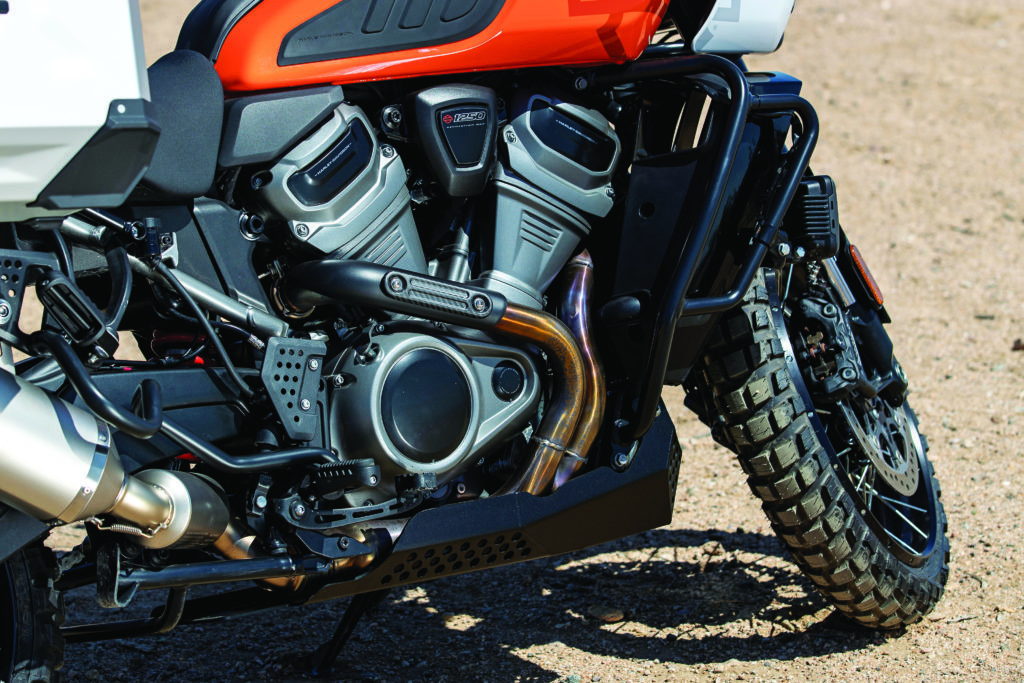
The Pan America provides a pleasant cockpit for munching miles, with a comfortably upright riding position and four choices for windshield placement over 1.8 inches to suit different rider sizes. Oddly, there are no detents to feel when moving the windscreen, and we were disappointed when the mechanism for moving the screens became impaired from the dust we kicked up while riding in off-road conditions. But while riding on paved roads, the windscreen provides a nice cocoon of deflection while not blocking sight lines. Lower and taller shields are optional accessories.
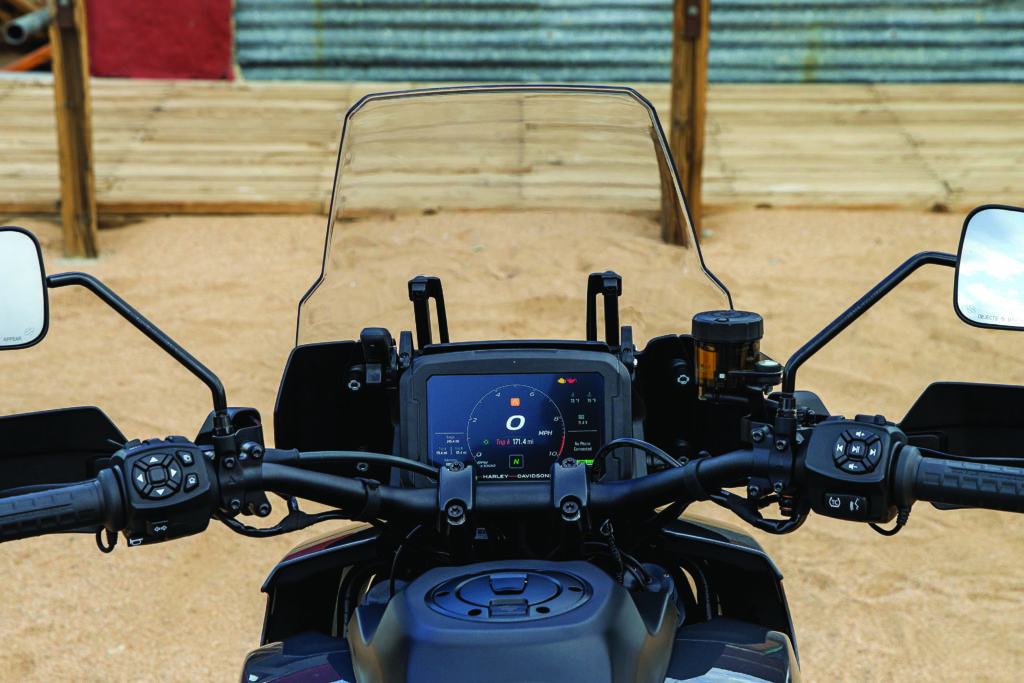
Speaking of options, we didn’t get to ride the base model 1250, which has the $17,319 MSRP. Instead, we were sampling the $19,999 1250 Special, which adds semi-active suspension with automatic preload adjustment, the adaptive headlight array that peers into corners, an Öhlins steering damper, centerstand, aluminum skid plate, engine protection bars, handguards, heated grips, and a tire-pressure monitoring system.
The Special also allows fitment of the ARH system, a $1,000 option, which our test bikes had. It operates seamlessly for as much ride-height variance it offers.
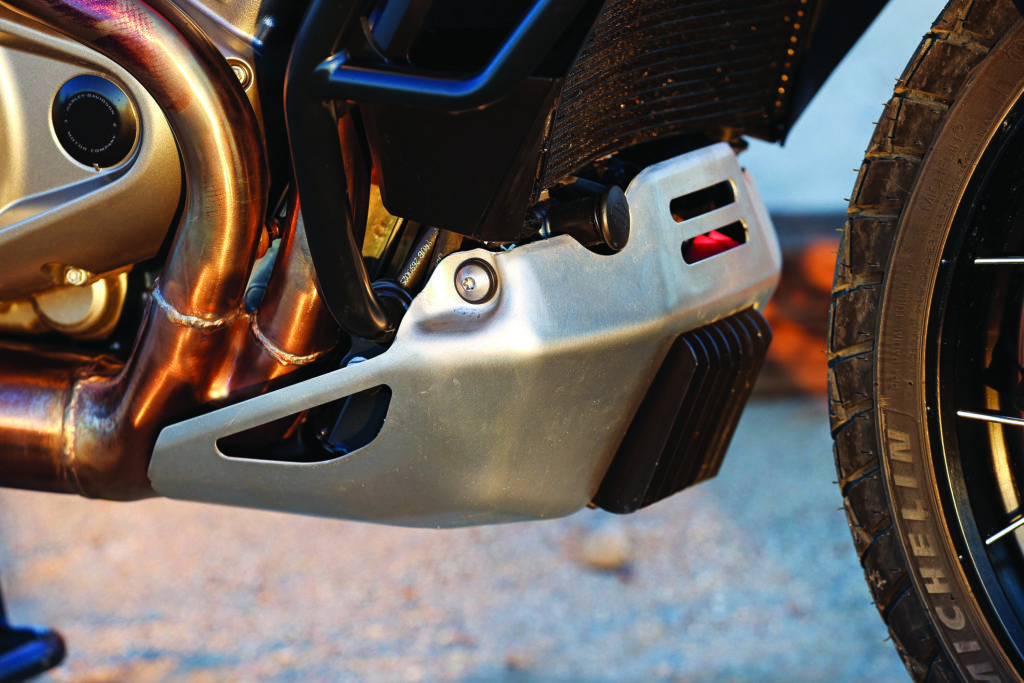

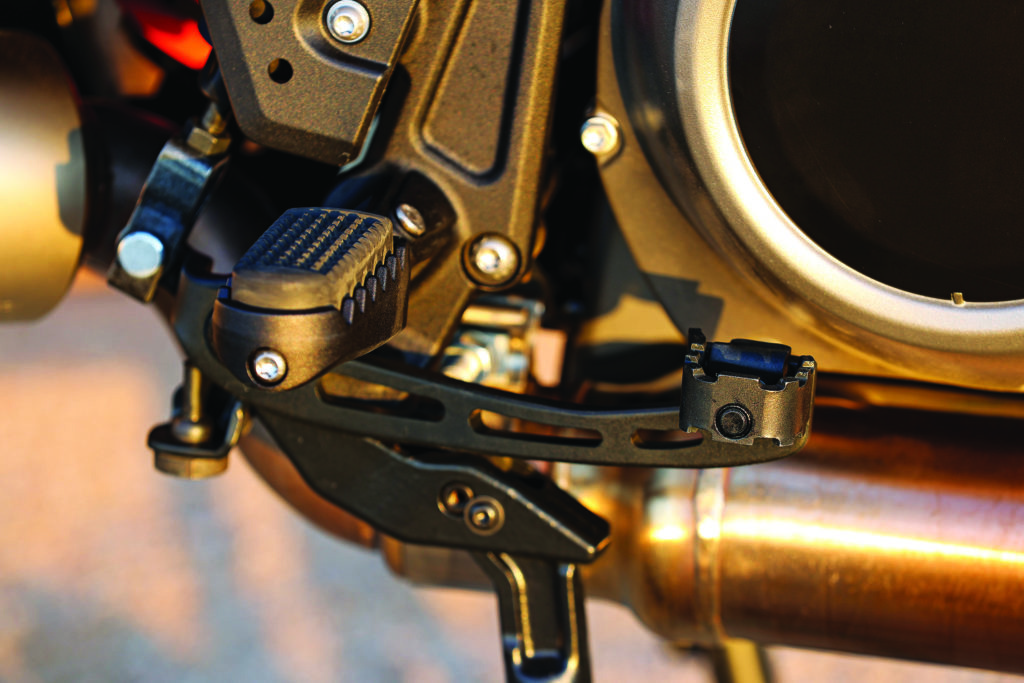

Don’t think you’d be slumming it on the base Pan Am, though. It is equipped with fully adjustable Showa suspension and a six-axis inertial-measurement unit (IMU) that informs lean-sensitive traction control, cornering ABS, cornering-enhanced linked braking, a hill-hold function and wheelie control.
All Pan Americas get the big TFT screen topped by non-reflective premium glass, as used on smartphones. It can be operated by touchscreen inputs when stopped or by switches on the handlebar, and it can also be linked to your phone via Bluetooth, with navigation provided through a free H-D app. It’s a nice-looking instrument panel, but some of the text on screen is quite small, especially considering the generous amount of real estate available on the large display.
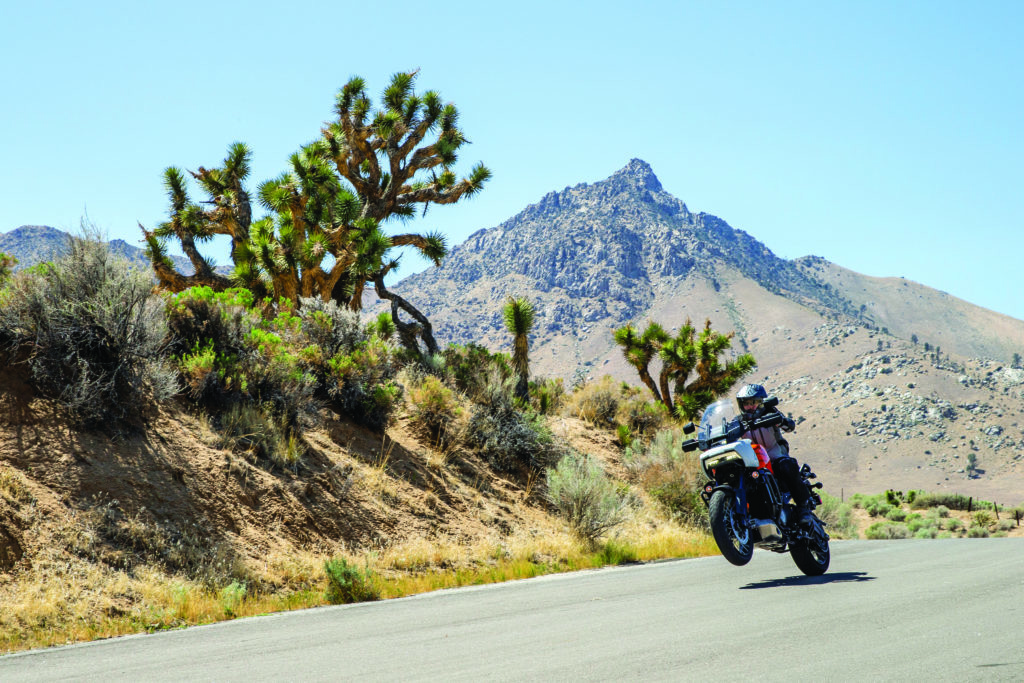
Four ride modes are pre-programmed to deliver different engine responses and corresponding settings for the electronic rider aids, plus a customizable menu. The Special has two additional modes that can be personalized. Ride modes also affect traction- and wheelie-control intervention, as well as suspension damping on the Special.
Sport mode delivers full and immediate engine response, but it comes with an abruptness during throttle reapplication. Road mode supplies smoother throttle response, but it also softens the ramping up of power felt in Sport and loosens up the suspension damping. To satisfy my preferences, I created a custom configuration based on Sport but dialed in with softer throttle response and less engine braking via a few button pushes. Handy!
Sport-Touring
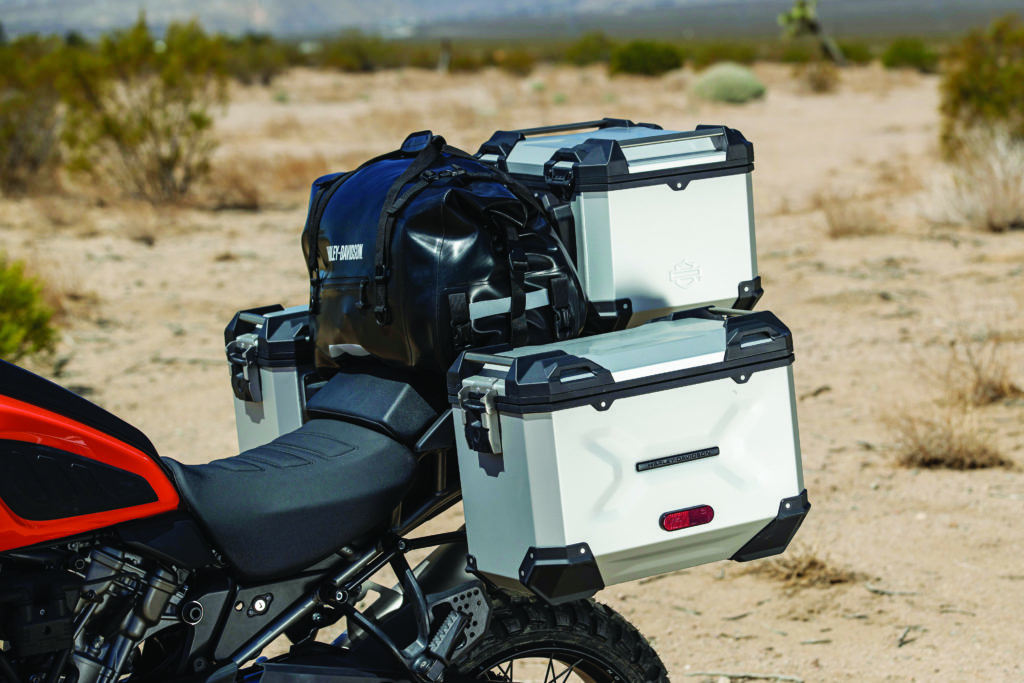
Although big ADV bikes have obvious off-road pretentions, they have evolved to become favorable choices for sport-touring adventures. Three luggage systems are available from H-D’s P&A catalog: a hardshell molded bag set; waterproof soft bags; and a rugged aluminum set.
The PA is a delight to carve up a twisty road, confidently bending into corners and displaying excellent stability when leaned over. It actually feels similar to Ducati’s Multistrada. The Special’s steering damper dulls low-speed agility slightly, and it’s a bit surprising the damper isn’t an electronically adjusted type that backs off damping at lower speeds when a damper isn’t really necessary.
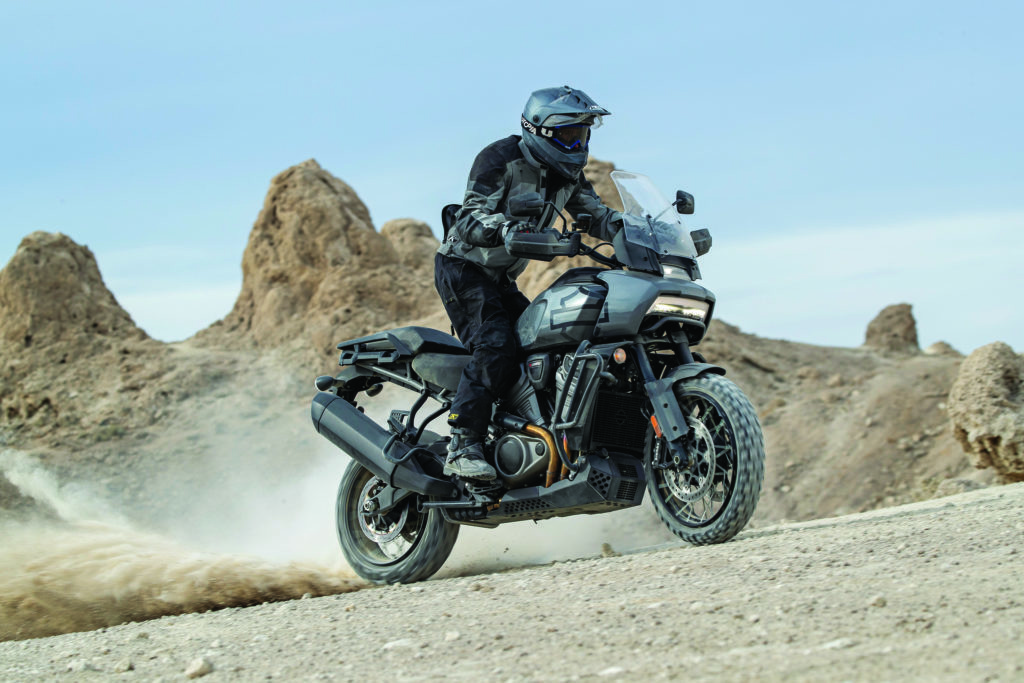
The Max motor shows its flexibility, pulling smartly even at low engine speeds. Revving it out past 6,750 rpm when torque peaks with 94 lb-ft will elicit a wide-eyed grin and activate the electronic wheelie control. The gearbox is decent if not excellent, although it is let down by not having a quickshifter like some other bikes in this class.
Brembo brake components are another bright spot, sporting radial-mount four-piston monoblock calipers and 12.6-inch rotors up front. They provide strong response without being overly touchy, and the linked function is nearly imperceptible.
The Pan America uses a 19-inch front and a 17-inch rear tire combo, fitted with Scorcher Adventure rubber co-developed with Michelin. They stuck firmly to the road even when the bike was leaned over further than the 42 degrees of lean angle when footpegs begin to skim the road. The stock cast-aluminum wheels are designed for light-duty off-road work, while rugged wire-spoke wheels are available as a $500 option. Their design allows the use of tubeless tires for easier roadside puncture repairs.
Getting Dirty
Some may question the abilities of big ADV bikes to traverse off-road terrain, and it’s true they can be a handful on technical trails. But it’s truly amazing the variety of technical terrain the Pan Am can negotiate.
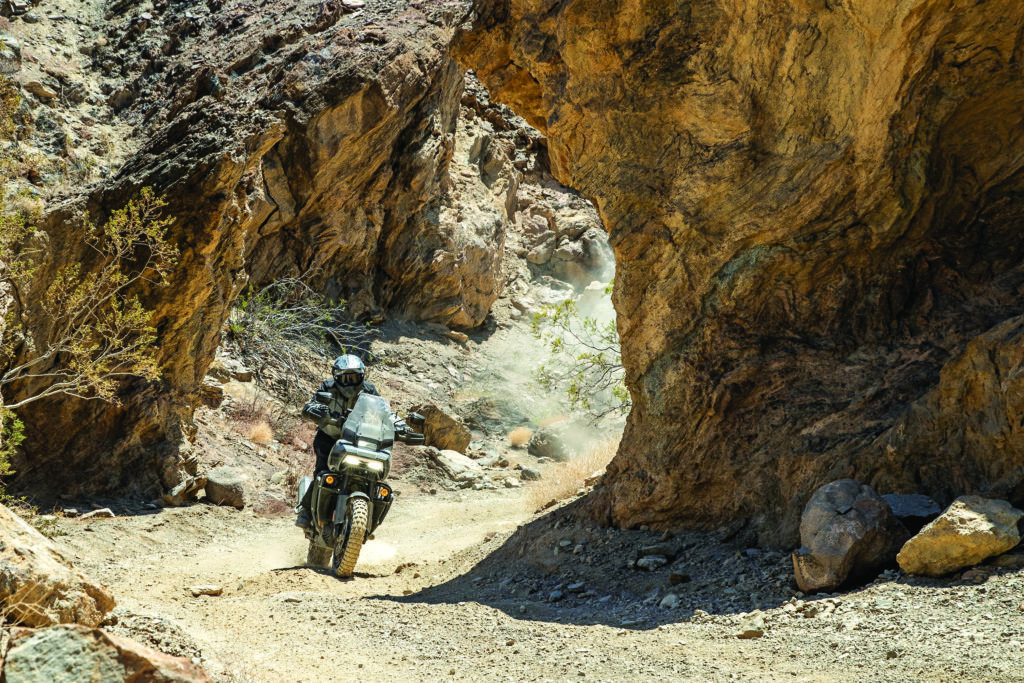
The final part of our first day of riding traversed a long stretch of unpaved roads, and the Pan Am felt at home in this mildly technical environment. H-D offers three ride modes for the dirt. I chose Custom Off-Road Plus for its lenient restrictions on traction and wheelie controls, as well as for switching off the rear ABS. Traction control can be disabled anytime by a long press on the TC button.
The motor impressed in these conditions, providing exactly as much thrust as desired, whether sliding the back end in a controllable drift or adding just a little grunt to tractor out of sandy corners. The Michelin Scorcher Adventures performed surprisingly well for such a grippy street tire. Through it all, the Pan America was intuitive and relatively easy to handle.
The most unpredictable moments came when setting the bike on its sidestand. The stand’s tab is deployed at an odd place ahead of the shifter, and the adaptiveness of the ARH causes the bike’s lean angle to be inconsistent when parked. ARH can be switched off if preferred.
Really Dirty
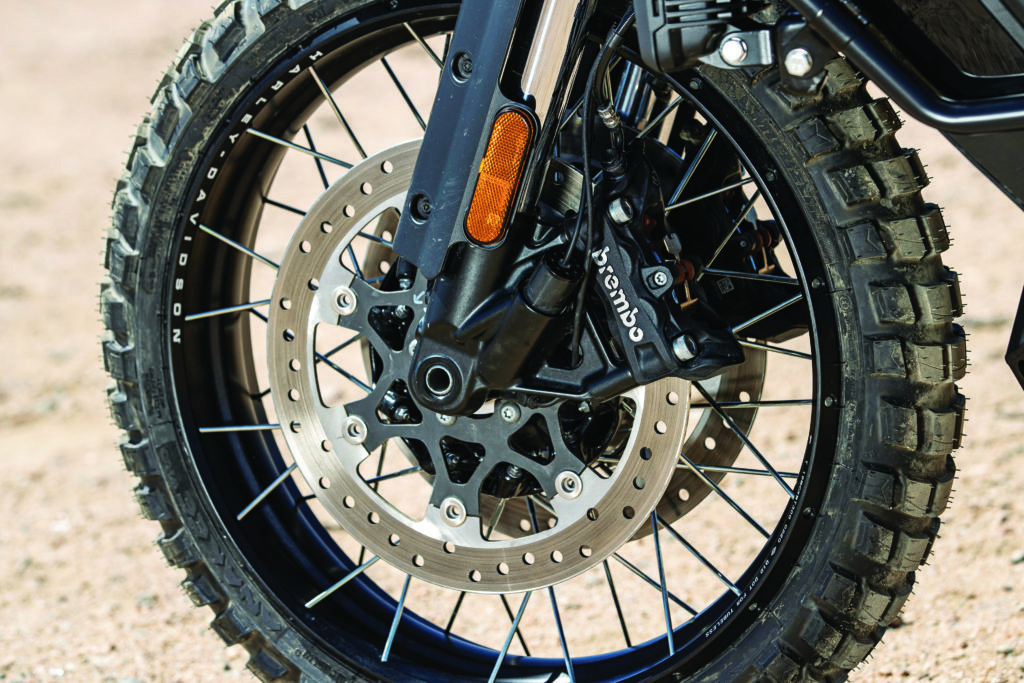
The Pan Am fleet was outfitted with Anakee Wild knobby tires for our second day of adventuring. These tires squirmed and lacked grip on paved roads compared to the stock rubber, but they were invaluable when piloting this 550-pound dirtbike in the sandy soil around the Trona Pinnacles, the site of scenes filmed for many movies and TV shows, including Planet of the Apes.
The Pan America again surprised with its sure-footedness off-road. It tracked fine in sand, and its magical motor doled out power in a predictable manner, allowing the use of second gear in turns that seemed more appropriate for first gear. If you’re going to pounce on rocks or even jump the Hog, definitely choose the firm damping from the customizable menu of options.
Game-Changer
The Pan America arrives at a turning point in Harley-Davidson’s history. While we can’t ever imagine the MoCo turning its back on its well-established cruiser/bagger/tourer market segments, this new ADV breathes life into the brand. And it’s not just the Pan Am, it’s also the other motorcycles with engines based on the Revolution Max that are sure to follow.
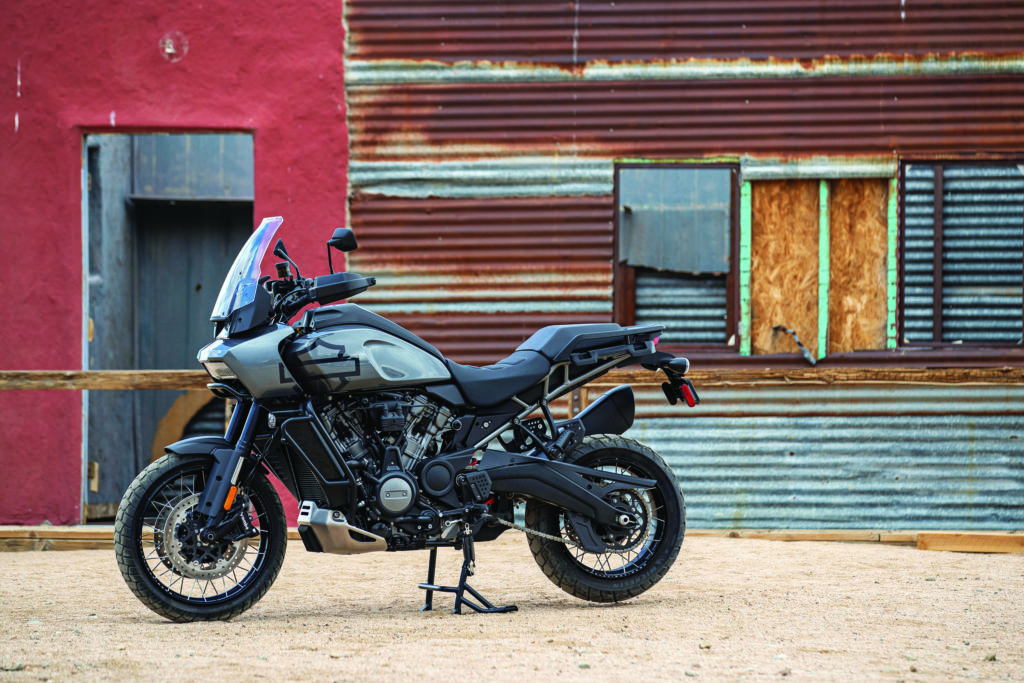
We’re happy to report the Pan America is far better than we expected. It’s a huge undertaking to start with a clean sheet and build a competitive motorcycle in a class far outside a company’s core competency, but H-D has done exactly that.
The Pan Am can do it all, rolling down the open road in comfort, untangling twisty roads with sporty faithfulness, and tackling off-road terrain with confidence previously unknown from a Harley. The MoCo should feel proud to have built a distinctive and convincing player in the hot segment of adventure-tourers.
But will it attract consumers who have previously shied away from H-D? Many riders on internet forums say yes.
“I’m a Harley ‘hater,’ but I seriously love this bike,” said an ADV forum commenter. “Cool looks, performance, handling, competitive with other machines, doing its own thing and bringing something unique to the ADV segment.”
“Never considered an H-D in my entire life,” said another commenter. “Now I think this is going to be my next bike.”
It’s a brand revolution, and we can’t wait to see what’s next with the Revolution Max and its upcoming variants.


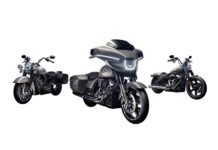
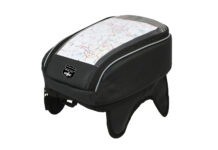
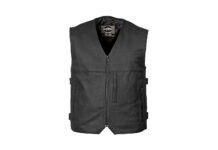
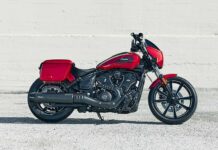
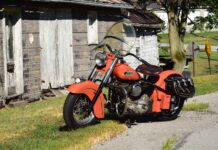
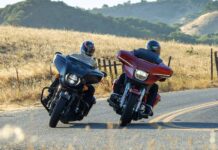










Can I get one for the 50/50/50 plan, 50$ down 50$ a week for 50 years?
If so sign me up.